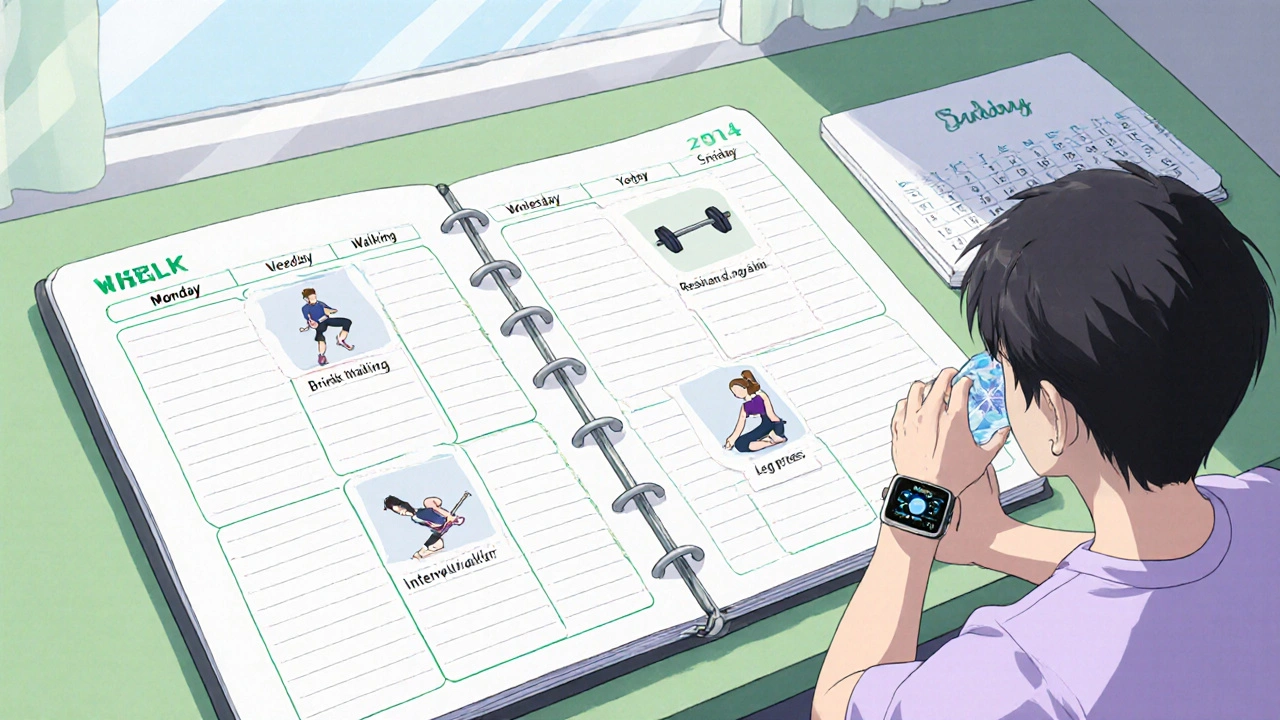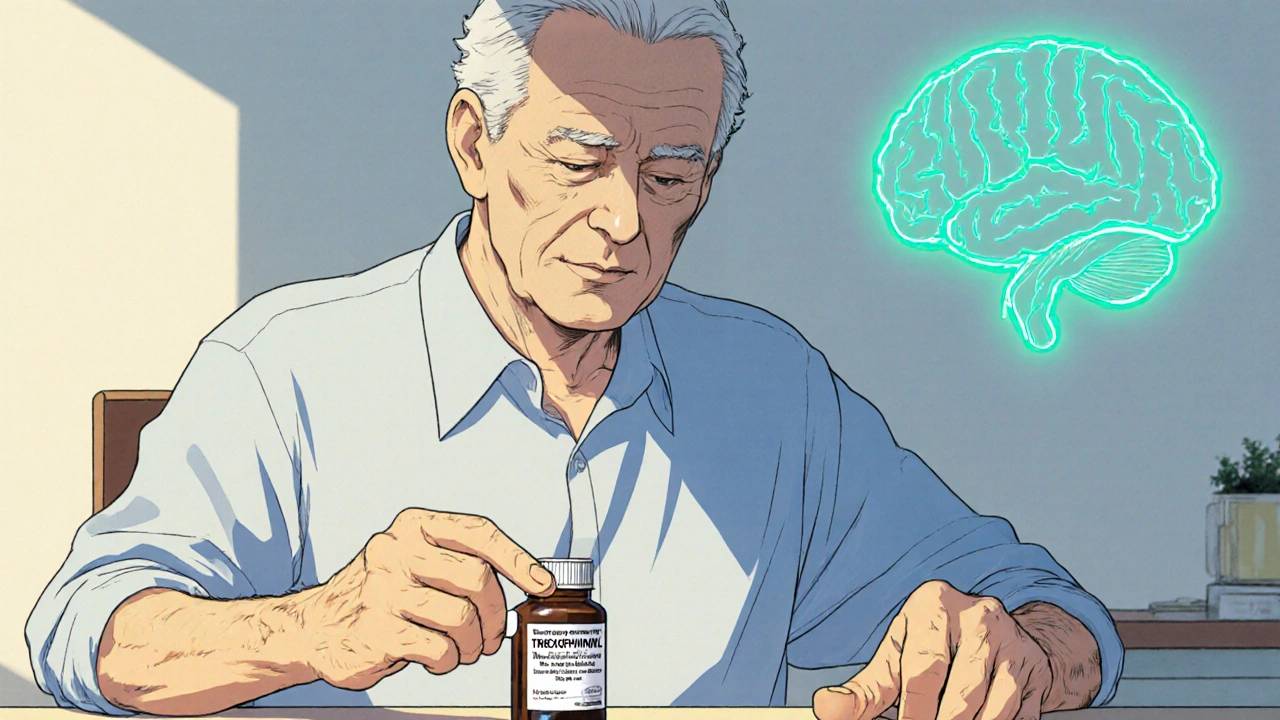Heart Rate Calculator for Parkinson's Exercise
Calculate Your Safe Exercise Heart Rate
Trihexyphenidyl can blunt heart rate responses during exercise. This calculator helps determine your appropriate exercise intensity based on your age and medication effects.
Quick Takeaways
- Trihexyphenidyl is an anticholinergic drug that can reduce tremor but may cause fatigue.
- Regular aerobic and strength training improves gait speed and balance in Parkinson's patients.
- Combining trihexyphenidyl with a tailored exercise program can offset some medication side‑effects.
- Start with low‑impact activities, monitor blood pressure, and adjust dosage under a neurologist’s guidance.
- Progressive overload and consistency are more important than intensity for long‑term mobility gains.
What Is Trihexyphenidyl?
Trihexyphenidyl is an anticholinergic medication approved for treating Parkinsonian tremor and drug‑induced extrapyramidal symptoms. It works by blocking acetylcholine receptors in the basal ganglia, helping to restore the dopamine‑acetylcholine balance that is disrupted in Parkinson's disease. Typical doses range from 1 mg to 10 mg per day, divided into two or three doses. Common side‑effects include dry mouth, blurred vision, urinary retention, and - crucial for our topic - fatigue or reduced coordination, which can affect exercise performance.
How Exercise Helps Parkinson's disease Mobility
Parkinson's disease (PD) is a progressive neurodegenerative disorder marked by loss of dopamine‑producing neurons in the substantia nigra. The resulting motor symptoms - tremor, rigidity, bradykinesia, and postural instability - limit daily activities. Exercise addresses these symptoms by:
- Increasing neurotrophic factors (e.g., BDNF) that support remaining dopaminergic neurons.
- Enhancing muscle strength and endurance, which combats bradykinesia.
- Improving proprioception and balance, reducing fall risk.
- Boosting cardiovascular health, which indirectly supports brain perfusion.
Interaction Between Trihexyphenidyl and Exercise
The anticholinergic action of trihexyphenidyl can blunt certain exercise benefits. By reducing cholinergic activity, the drug may lower heart‑rate variability and blunt the autonomic response to aerobic work, leading to perceived fatigue. On the flip side, its tremor‑reducing effect can make fine‑motor tasks (such as hand‑grip exercises) easier to perform. Understanding this trade‑off helps clinicians design programs that capitalize on tremor control while mitigating fatigue.
Key points to consider:
- Timing: Take trihexyphenidyl after a light breakfast and schedule the main workout session 1-2 hours later, when plasma concentrations peak.
- Intensity: Aim for moderate intensity (40‑60% VO₂max) rather than high‑intensity interval training, which may exacerbate medication‑induced dizziness.
- Hydration: Anticholinergic drugs dry mucous membranes, so adequate fluid intake is essential during and after exercise.
Practical Exercise Plan for Patients on Trihexyphenidyl
The following 12‑week program balances aerobic conditioning, resistance training, and flexibility. Adjust the schedule based on personal tolerance and neurologist feedback.
| Day | Activity | Duration / Sets | Intensity Goal | Notes (Medication Interaction) |
|---|---|---|---|---|
| Monday | Brisk walking or stationary bike | 30 min continuous | RPE 11‑12 (moderate) | Take trihexyphenidyl 1 hr before; monitor for excessive fatigue. |
| Tuesday | Resistance training (upper body) | 3 sets × 10‑12 reps | 70% 1‑RM | Focus on slow, controlled movements; avoid rapid jerks. |
| Wednesday | Yoga or Tai Chi (balance focus) | 45 min session | Low‑impact, breath‑centered | Hydration crucial; anticholinergic dryness can affect swallowing. |
| Thursday | Resistance training (lower body) | 3 sets × 10‑12 reps | 70% 1‑RM | Use seated leg press if postural instability occurs. |
| Friday | Interval walking (2 min fast, 2 min easy) | 6 cycles | Fast intervals at RPE 13‑14 | Check blood pressure before and after; trihexyphenidyl may lower orthostatic response. |
| Saturday | Stretching & core stability | 20 min | Gentle, pain‑free | Maintain upright posture; avoid neck extension if dry mouth causes discomfort. |
| Sunday | Rest or leisurely walk | Optional 15‑20 min | Very low intensity | Use this day to assess overall energy levels. |

Safety Tips and Common Pitfalls
When integrating trihexyphenidyl with an exercise regimen, keep these safeguards in mind:
- Monitor Heart Rate: Anticholinergic drugs can blunt the typical rise in heart rate. Use a wearable monitor and aim for 40‑60% of age‑predicted max.
- Watch for Orthostatic Drops: Stand up slowly after seated or supine exercises; a sudden drop in blood pressure can cause dizziness.
- Avoid Dehydration: Dry mouth is a known side‑effect. Sip water every 15 minutes during workouts.
- Check Medication Timing: If fatigue spikes, consider shifting the dose to earlier in the day and discuss with a neurologist.
- Progress Gradually: Increase duration by no more than 10% per week to prevent overexertion.
Frequently Asked Questions
Can trihexyphenidyl replace the need for exercise in Parkinson's?
No. While trihexyphenidyl helps control tremor, it does not address muscle weakness, balance deficits, or cardiovascular health. Exercise offers neuroprotective benefits that medication alone cannot provide.
Is it safe to do high‑intensity interval training while on trihexyphenidyl?
Generally not recommended for most patients. The drug can blunt autonomic responses, making it harder to detect early signs of overexertion. Moderate‑intensity workouts are a safer first step.
What is the ideal time of day to exercise if I take trihexyphenidyl twice daily?
Schedule the main session 1‑2 hours after the morning dose, when peak plasma levels help dampen tremor. Evening workouts can be done after the second dose, but keep intensity low to avoid sleep disturbances.
Will trihexyphenidyl affect my heart rate during cardio?
Yes, it may blunt the rise in heart rate and reduce perceived exertion. Use a heart‑rate monitor and aim for a target zone based on perceived effort rather than just pulse.
Can I combine trihexyphenidyl with other Parkinson's meds and still exercise?
Yes, many patients take levodopa, MAO‑B inhibitors, or dopamine agonists alongside trihexyphenidyl. However, each drug has its own side‑effect profile. Coordinate with your neurologist to adjust doses as your fitness improves.


Maridel Frey
October 19, 2025 AT 12:32Thank you for sharing this comprehensive guide on integrating trihexyphenidyl with exercise. The detailed weekly plan provides a clear framework that clinicians can adapt for individual patients. Emphasizing moderate intensity and proper hydration aligns well with current best practices for managing medication‑induced fatigue. It is also prudent to monitor orthostatic blood pressure changes, especially in the early weeks of the program. Overall, this resource balances pharmacologic considerations with pragmatic exercise recommendations, making it a valuable tool for multidisciplinary care.
Sarah Unrath
October 20, 2025 AT 20:30i coudnt help but i think you should start woth a jog even if the med makes u sleepy its like a double whammy but dont worry you can push thru just drink water and maybe take the dose earlier
James Dean
October 22, 2025 AT 04:26exercise in Parkinson's feels like a quiet dialogue between mind and body, the medication sets the stage and the movement writes the story, each session subtly reshapes neural pathways, progress may be imperceptible yet it accumulates over time
Monika Bozkurt
October 23, 2025 AT 12:23The proposed regimen adeptly leverages neuroplasticity through repetitive motor learning, thereby potentiating dopaminergic signaling pathways. By integrating aerobic conditioning with resistance training, the protocol addresses both cardiovascular reserve and muscular hypertrophy, essential for mitigating bradykinesia. The emphasis on progressive overload adheres to the principle of load‑induced synaptic strengthening, a cornerstone of motor rehabilitation. Additionally, the hydration guidelines account for anticholinergic‑induced xerostomia, preserving mucosal integrity during exertion. Collectively, these elements constitute a robust, evidence‑informed strategy for enhancing functional mobility in Parkinson's disease.
parth gajjar
October 24, 2025 AT 20:20The very notion of pairing a sedative anticholinergic with vigorous movement evokes a tragic ballet of contradictions. One moment the drug whispers calm, silencing the tremor that haunts the patient. The next moment the same molecule drapes a veil of fatigue over the muscles, as if a dark curtain descends upon the stage. Yet within this darkness, the spark of determination flickers, refusing to be extinguished. The athlete’s heart, though muted, beats a steady rhythm, yearning for the cadence of a treadmill. Each step becomes an act of rebellion against the pharmacologic shackles. The sweat that beads the brow is not merely moisture but a testament to resilience. The dry mouth, a relentless desert, cannot swallow the silent cries for freedom. As the patient lifts a weight, the tremor recedes, a fleeting triumph that echoes through the synapses. The mind, paradoxically, is both captive and liberated, observing the paradox with detached curiosity. The therapist watches, a silent guardian, noting every subtle shift in posture. The medication’s peak concentration arrives like a tide, swelling the muscles with temporary grace. The subsequent decline brings a gentle lull, urging the body to rest before the next crescendo. This ebb and flow mirrors the very nature of Parkinson’s itself, a rhythm of loss and gain. The program’s progressive overload becomes a metaphorical mountain, each ascent demanding courage. The patient climbs, stumbling yet persisting, each plateau a new horizon. The balance exercises, akin to tightrope walking, cultivate proprioceptive awareness that defies the drug’s fog. Hydration, a simple act, counteracts the insidious dryness, restoring a semblance of normalcy. In the grand tableau, medication, movement, and will intertwine, forging a fragile alliance. Ultimately, the story is not one of defeat but of nuanced perseverance, a narrative written in sweat, resolve, and the faintest tremor of hope.
Jameson The Owl
October 26, 2025 AT 03:16It is imperative to recognize that trihexyphenidyl, while beneficial for tremor suppression, possesses pharmacodynamic properties that can attenuate autonomic responsiveness during cardiovascular exercise; consequently, practitioners must calibrate intensity thresholds with heightened vigilance. Moreover, the interplay between anticholinergic-induced xerostomia and thermoregulation necessitates a systematic hydration protocol to avert hyperthermic episodes, especially in ambient temperatures exceeding normative ranges. Clinical observation further suggests that scheduling aerobic sessions within the pharmacokinetic window of 1 to 2 hours post‑dose optimizes neuromuscular coordination, thereby enhancing exercise efficiency without compromising safety. Finally, integrating periodic orthostatic assessments into the training regimen affords a proactive measure to identify latent hypotensive trends, thereby safeguarding patient stability throughout progressive overload cycles.
Rakhi Kasana
October 27, 2025 AT 11:13The silent courage of a trembling hand finding rhythm is nothing short of poetry.
Sunil Yathakula
October 28, 2025 AT 19:10Hey man keep at it dont let the dry mouth slow u down just sip water every few minutes and stay chill the progress may feel slow but every little move adds up trust the process and you’ll see results soon
Christian Georg
October 30, 2025 AT 03:06Great summary! For anyone starting out, I recommend beginning with 10‑minute walks and gradually adding a set of body‑weight squats, listening to your body’s feedback and adjusting the trihexyphenidyl timing if fatigue spikes 😊 Keep tracking heart rate and stay consistent, results will follow.